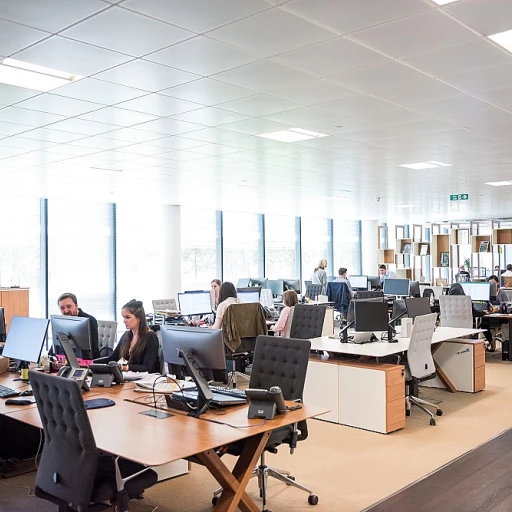Understanding Skills Gap Analysis
Diving into Skills Gap Analysis
In any thriving organization, a Chief Human Resources Officer (CHRO) plays a pivotal role in conducting skills gap analysis. This isn't just business jargon—it's a critical function that can shape a company's future success. Imagine being the detective of your team, sniffing out any missing pieces in your workforce that's keeping your company from hitting its full potential. That’s essentially what you’re doing with skills gap analysis. So, why is this exercise so vital? Every business is only as strong as its team. Even the most talented employees can have skills gaps that, if left unaddressed, may hold back the business. Conducting a skills gap analysis involves identifying the current skills of employees and comparing them with the skills needed to achieve the company’s objectives. Here's a simple analogy: think of your organization as a ship. The skills gap analysis is the map that shows you which parts of your ship need repairs to sail smoothly. Without it, you’re steering blind. Conducting a skills gap analysis requires you to thoroughly understand your organization’s current skills set. One practical way to do this is through performance reviews and training development programs. These tools are like magnifying glasses that help you zero in on the skills employees need to either advance in their careers or to fill skill gaps in the company. Of course, it's not all about hard skills like proficiency in a certain software. Soft skills such as communication, teamwork, and problem-solving are equally—if not more—important. They help in creating a cohesive work environment, which is crucial for any business aiming for long-term success. Ultimately, a well-executed skill gap analysis leads to targeted training programs designed to bridge these gaps. This not only benefits the organization by aligning employee skills with company goals but also ensures employee development in the long run. It's time well spent that pays dividends by way of a more capable, confident workforce. For those of you wearing the CHRO hat, understanding how these analyses can transform your team’s capabilities is crucial. Not only will it enhance employee learning and development, but it also positions your company as a force to reckon with in the talent marketplace.Core Competencies for Effective CHROs
The Essential Skills Toolkit for Modern CHROs
To effectively bridge the gaps in any organization, a Chief Human Resources Officer needs a toolkit of core skills. You can't just wing it with gut feelings; it's about making informed decisions by understanding the skill gaps in your business. Start by actively conducting skills gap analysis to get a clearer view of the skills needed and those that are missing in your team. Thomas, a seasoned HR pro, shared his story about identifying skills gaps in his company, which helped them create tailored training programs that boosted their employees’ performance levels. This practical approach informs strategic decisions and employee development plans.Analysis Skills That Make a Difference
Sometimes it looks like making sense of chaos. The goal is to systematically analyze the current skills of your workforce to pinpoint where help is most needed. This isn’t just about running performance reviews for the formality; it’s about understanding the current skill levels and integrating training programs that translate results. Take Sarah, for example, an HR leader who used data-driven analysis to optimize training development in her organization, leading to a more competitive business advantage. By being methodical, CHROs can spin data into actionable insights, refining their focus, and bolstering their teams effectively.Training That Transforms
We all love a good success story. Jessica, a forward-thinking HR chief, embraced employee training and development to not only fill skill gaps but to future-proof the company. Tailored training programs were implemented, encouraging a culture of learning and development. This forward-looking approach ensured her team was equipped with the skills needed for today and tomorrow, aligning with the company's objectives. It's all about continuous learning, right?Company Culture: Strengthening Bonds Through Communication and Collaboration
Open communication and teamwork are the backbone of any HR strategy. Amy, an adept HR officer, knows first-hand that creating a culture of collaboration can break down silos and build a more inclusive organization. By fostering an environment where training, real-time feedback, and open dialogue are normalized, employees feel valued and motivated. Result? Reduced skills gaps and a culture that thrives on shared success.A Human Touch
Data and analysis can tell a lot, but never underestimate the power of relationships and intuition. While tools and metrics play a crucial role in addressing skill gaps, the personal touch keeps teams engaged and committed. Doug, a CHRO with two decades under his belt, highlights how connecting with employees on a personal level allows HR leaders to identify areas for improvement naturally and craft solutions that truly resonate. In this age of transformation, it's about aligning business goals with employee ambitions. Effective CHROs who master these skills not only bridge skill gaps but drive their organizations forward.Strategic Thinking and Leadership
Strategic Role Beyond the Office Desk
One of the extraordinary abilities of a Chief Human Resources Officer (CHRO) is to hold the reins of strategic thinking and leadership. Such prowess is not just about leading a team or making top decisions. It's about reading between the lines in business reports, interpreting them, and aligning both employee skills and organizational goals for climbing the ladder of success. While conducting a skills gap analysis helps identify skills within the company that require nurturing or even transforming. The CHRO should conduct skills analysis regularly to scrutinize the current skills employees have and which skills are needed for the dynamic business environment. This analytical method is more than just about filling those gaps; it's about spotting hidden talents that have the potential to illuminate future paths.Pioneering Thought Leadership to Fuel Employee Development
The CHRO's hour isn’t limited to focusing on the immediate. Instead, they lock in their vision on the future. They fill this role by identifying skills that go beyond technical prowess to encompass soft skills vital for driving an adaptable workforce. It's about fostering a culture of continuous learning so training development isn’t just an annual checkbox but an ongoing journey for employee development. By implementing innovative training programs, organizations can bridge the skills gaps that often hinder progress. A CHRO leads the charge by harnessing data from performance reviews to design a training development plan that tailors to the individual and organizational goals. It’s this strategic planning that transitions a reactive workforce into a proactive business powerhouse.The Power of a Collaborative Force
Never underestimate the power of collaboration in business success. Communication is the bedrock of organizational cohesion and morale. Here, strategic thinking joins forces with effective leadership as a CHRO creates a platform for idea sharing, talent pooling, and feedback to flow seamlessly. This approach plays a vital role in ensuring that skills gap interventions are both realistic and achievable. By fostering transparent communication channels, the CHRO can promote a culture where ideas and skills naturally exchange, thus allowing the company to adapt to changes swiftly. If you've found this useful, consider exploring more on enhancing workplace dynamics here.Data-Driven Decision Making
Integrating Data-Driven Insights in HR Management
In an organization, successful strategic thinking goes hand-in-hand with making decisions based on solid data. A Chief Human Resources Officer (CHRO) leverages data-driven insights to bridge any skills gap and enhance the workforce. By conducting a comprehensive skills gap analysis, companies pinpoint where their employees' abilities fall short and need improvement. Analyzing data from performance reviews proves useful in identifying these gaps. This involves collecting data on current skills and comparing it against the skills needed for the company's growth. Utilizing an analysis template can streamline how you identify missing talents within your team or company, swiftly cutting through guesswork to actionable intelligence. Being well-informed aids a CHRO in rolling out effective training programs to fill those skills gaps. Training development tailored to specific skills guarantees employees are continuously learning and developing in areas crucial for business success. Such data-driven strategies don't only solve skill-related concerns, but mold a business environment that always aligns workforce capabilities with the ever-evolving needs of the organization. Let's not forget the importance of soft skills, which can sometimes slip through a strict data lens. While technical capabilities are vital, soft skills bolster team collaboration and innovation. Here lies the nuanced blend of using data and human intuition. Real success stories exist where companies, by analyzing the right data, have avoided skill gaps that hinder growth. When employee development is prioritized, both the workforce and the organization are future-ready.Communication and Collaboration
Fostering Clear Communication and Teamwork
Understanding and addressing skill gaps in the workforce requires open communication and effective collaboration. As a CHRO, it's vital to cultivate an environment where employees feel comfortable sharing their current skill levels and areas where they need development. Encouraging input from employees during performance reviews can illuminate where skill gaps exist and how they might be filled with the right training programs. To effectively conduct skills gap analysis, professionals must develop strong communication skills to solicit feedback and insights from various departments within the organization. A CHRO's role in bridging skills gaps hinges on their ability to communicate strategies clearly and collaborate with team leaders to implement successful training and development initiatives. Ensuring that everyone is on the same page can help identify skills needed across the organization, allowing for more targeted learning and development efforts. Open dialogue between different departments can also shed light on potential obstacles in training implementation and workforce development. Furthermore, fostering collaboration amongst employees can lead to innovative problem solving, which could facilitate skill acquisition in unexpected areas. For example, cross-functional projects may introduce employees to new responsibilities and opportunities for growth, naturally addressing skill gaps within the company. Enabling effective communication across the company not only helps in recognizing skills gaps but also maximizes the potential of every team member. A supportive and communicative work culture encourages continuous employee development and commitment to the organization's long-term success. Notably, combining data-driven decision-making—an aspect highlighted in earlier sections—with effective communication can yield insights that are critical in determining employee skills, identifying training needs, and developing actionable strategies to fill talent gaps.Future-Proofing the Workforce
Preparing for Tomorrow's Challenges
As the world keeps changing, businesses must ensure their workforce is ready for the future. This involves more than just filling skill gaps; it's about preparing employees for roles that might not even exist yet. Chief Human Resources Officers (CHROs) play a crucial role in this process, using their skills to anticipate future needs and develop strategies to meet them.
One of the first steps in future-proofing the workforce is conducting skills gap analysis. This involves identifying the skills employees currently have and comparing them to the skills needed for the company to succeed in the future. By doing this, CHROs can pinpoint areas where training and development are required, ensuring that the organization is not caught off guard by changes in the business environment.
Investing in Continuous Learning
Training programs are essential for filling skill gaps, but they must be part of a broader commitment to continuous learning. CHROs should foster a culture where learning and development are ongoing priorities. This means encouraging employees to take ownership of their skill development and providing them with the resources to do so.
Moreover, it's important to focus on both technical and soft skills. While technical skills are often the focus of training programs, soft skills such as communication, teamwork, and adaptability are equally important for long-term success. By emphasizing these skills, CHROs can help build a more resilient and versatile workforce.
Embracing Technology and Innovation
Technology is reshaping the workplace, and CHROs must be at the forefront of integrating new tools and platforms that enhance learning and development. This includes leveraging data analytics to track employee progress and identify skills gaps, as well as utilizing online learning platforms to offer flexible and accessible training options.
By embracing innovation, CHROs can ensure that their organization remains competitive and that employees are equipped with the skills needed to thrive in an ever-evolving business environment.
Building a Culture of Agility
Finally, future-proofing the workforce requires creating a culture of agility. This means fostering an environment where change is seen as an opportunity rather than a threat. CHROs should encourage employees to be open to new ideas and adaptable to new situations, helping the organization to quickly respond to changes in the market.
In conclusion, future-proofing the workforce is an ongoing process that requires a strategic approach to skills development. By focusing on skills gap analysis, continuous learning, technology, and agility, CHROs can ensure that their organization is ready to meet the challenges of tomorrow.





